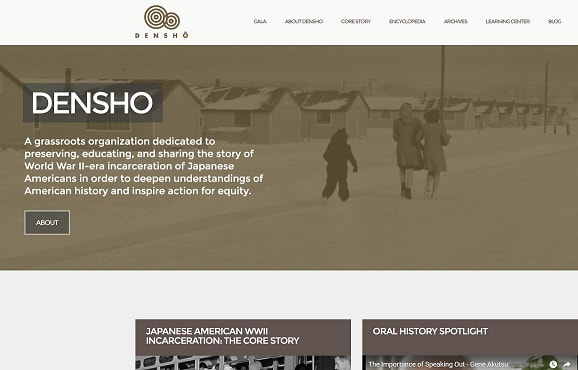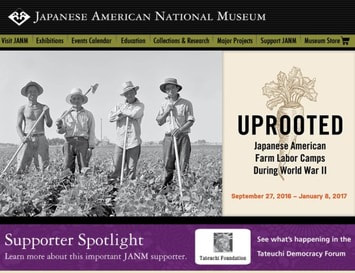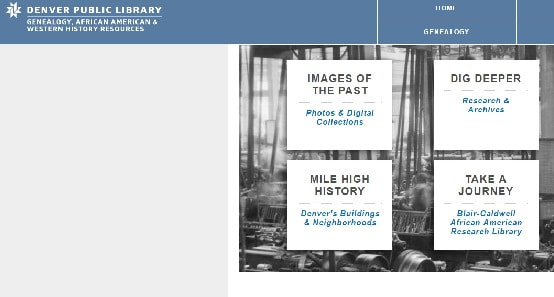WEBSITES
DENSHOArchival site for the Japanese-American experience in World War II and relocation centers throughout the United States, including photos, audio interviews, educational materials.
CSU PUEBLOCollections that preserve the heritage of Southern Colorado’s diverse ethnic, racial, and cultural groups.
|
JAPANESE AMERICAN NATIONAL MUSEUMWebsite for the Japanese-American National Museum in Los Angeles, California. Information about the War Relocation Authority camps and exhibits, programs.
DENVER PUBLIC LIBRARYCelebrating Hispanic Heritage in Colorado, a collection of papers and records of Hispanic individuals and organizations in Colorado: correspondence, photographs, scrapbooks, meeting minutes and more.
|
As she reveals the hardships and heartache of her characters, Purvis-Smith neither judges nor condones the collective and individual missteps of the residents of Greenwood or the country. Rather, she reminds us that we are all just trying to do the best that we can with what we've got. Though progress isn't absolute, neither is despair. The triumph is that we keep moving forward.
Christina Putney
BOOKS READ BY CHARACTERS IN GREENWOOD RIVEN
The Story of Little Black Sambo
Bannerman, Helen. First published in 1899.
Critics originally thought Bannerman, a Scottish author, portrayed this South Indian boy and his family positively. In 1932, Langston Hughes criticized it as a typical “pickaninny” storybook hurtful to black children, and it gradually disappeared from lists of recommended stories for children. However, it was still read by Greenwood’s children in the 1940s.
When Children Ask
Bro, Margueritte Harmon. Chicago: Willett, Clark & Co., 1940
A prolific writer of children's books and religious literature and mother of four, Bro urges parents troubled by their children's questions to face them frankly and answer from their own best experiences. She gives no categorical answers, recognizing that every parent and child are different. (She was married to Albin Bro, a missionary, college president, and a Foreign Service Reserve officer to Seoul, South Korea after the Korean War.) She wrote this book while coasting along South America. (Exerpts from The Journal of Religion, October, 1940.)
For Whom the Bell Tolls
Hemingway, Ernest. NY: Charles Scribner’s Sons, 1940.
The story of Robert Jordan, a young American attached to a republican guerrilla unit during the Spanish Civil War.
Hold Autumn in Your Hand
Perry, George Sessions. NY: Viking, 1941.
Perry, 1941 National Book Award winner, tells about Sam Tucker’s determination to use his knowledge of the land to provide for his family. Tucker contracts to farm sixty-eight acres of rich bottomland soil despite earning only six bits a day.
Berlin Diary: The Journal of a Foreign Correspondent, 1934-1941
Shirer, William L. NY: Alfred A. Knopf, 1941.
A firsthand account of the rise of Nazi Germany.
Embezzled Heaven
Werfel, Franz Viktor. 1939.
Werfel was born in Prague, a child of progressive Jewish parents, and was virtually raised by his Czech Catholic governess. He was a friend of Franz Kafka and married Alma Mahler, widow of Gustav Mahler. His 1930 novel, The Forty Days of Musa Dagh, drew world attention to the Armenian genocide during and after World War I. He left Austria for France after the Anschluss in 1938, and, with the German occupation of France, he was forced to flee Europe in 1940. He settled in southern California. Embezzled Heaven, a story about an old Catholic peasant servant, was made into a movie in 1958.
Bannerman, Helen. First published in 1899.
Critics originally thought Bannerman, a Scottish author, portrayed this South Indian boy and his family positively. In 1932, Langston Hughes criticized it as a typical “pickaninny” storybook hurtful to black children, and it gradually disappeared from lists of recommended stories for children. However, it was still read by Greenwood’s children in the 1940s.
When Children Ask
Bro, Margueritte Harmon. Chicago: Willett, Clark & Co., 1940
A prolific writer of children's books and religious literature and mother of four, Bro urges parents troubled by their children's questions to face them frankly and answer from their own best experiences. She gives no categorical answers, recognizing that every parent and child are different. (She was married to Albin Bro, a missionary, college president, and a Foreign Service Reserve officer to Seoul, South Korea after the Korean War.) She wrote this book while coasting along South America. (Exerpts from The Journal of Religion, October, 1940.)
For Whom the Bell Tolls
Hemingway, Ernest. NY: Charles Scribner’s Sons, 1940.
The story of Robert Jordan, a young American attached to a republican guerrilla unit during the Spanish Civil War.
Hold Autumn in Your Hand
Perry, George Sessions. NY: Viking, 1941.
Perry, 1941 National Book Award winner, tells about Sam Tucker’s determination to use his knowledge of the land to provide for his family. Tucker contracts to farm sixty-eight acres of rich bottomland soil despite earning only six bits a day.
Berlin Diary: The Journal of a Foreign Correspondent, 1934-1941
Shirer, William L. NY: Alfred A. Knopf, 1941.
A firsthand account of the rise of Nazi Germany.
Embezzled Heaven
Werfel, Franz Viktor. 1939.
Werfel was born in Prague, a child of progressive Jewish parents, and was virtually raised by his Czech Catholic governess. He was a friend of Franz Kafka and married Alma Mahler, widow of Gustav Mahler. His 1930 novel, The Forty Days of Musa Dagh, drew world attention to the Armenian genocide during and after World War I. He left Austria for France after the Anschluss in 1938, and, with the German occupation of France, he was forced to flee Europe in 1940. He settled in southern California. Embezzled Heaven, a story about an old Catholic peasant servant, was made into a movie in 1958.
RESOURCES DEPICTING THE ERA
Bless Me, Ultima
Anaya, Rudolfo. Berkeley, CA: TQS Publications, 1972.
A coming of age story that mirrors Chicano culture of the 1940s in rural New Mexico.
Colorado’s Japanese Americans: From 1886 to the Present
Hosokawa, Bill. Boulder: University Press of Colorado, 2005.
Issei: The Shadow Generation: Rooted in Japanese Values,
Planted on American Soil
Matsueda, Tsukasa. San Francisco: Japanese Cultural and Community Center of Northern California, 2007.
Within a Stone Throw: Bent County People in the War,
Pearl Harbor, December 7, 1941, to V-J Day, August 14, 1945
McDermott, R.B. La Junta Printing Co., 1945.
A compendium of the movements of men and women from Bent County, Colorado, who answered their country’s call. Bent County is but part of the original Greenwood County established from Arapaho and Cheyenne lands when Colorado became a territory.
We Band of Angels: The Untold Story of American Nurses Trapped on Bataan by the Japanese
Norman, Elizabeth. NY: Pocket Books, 1999.
The saga of women and war. Nurses set up field hospitals in the jungles of Bataan and tunnels of Corregidor. After Bataan and Corregidor fell, they endured three years in internment camps.
Beyond the Latino World War II Hero:
The Social and Political Legacy of a Generation
Rivas-Rodriguez, Maggie and Emilio Zamora, eds. Austin: University of Texas Press, 2009.
An anthology that makes use of the oral narratives generated by the U.S. Latino and Latina World War II Oral History Project.
Double Victory:
A Multicultural History of America in World War II
Takaki, Ronald. NY: Little, Brown and Company, 2000
In his scrutiny of the "good war," Takaki shows that minorities were not just victims but were also actors in history.
Every War Has Two Losers: William Stafford on Peace and War
Stafford, Kim, ed. Minneapolis: Milkweed Editions, 2003.
A son’s tribute to William E. Stafford; a collection of the father’s poems and prose. Stafford was a conscientious objector in World War II who performed alternative service in the Civilian Public Service camps.
We Chose Colorado: Japanese American Voices
Lebra, Joyce. Palm Springs, CA: Old John, 2016
An Invaluable compendium of interviews, particularly with the Issei and Nisei generations of Japanese Americans as they recall their agricultural and business successes in the first half of the twentieth century.
Anaya, Rudolfo. Berkeley, CA: TQS Publications, 1972.
A coming of age story that mirrors Chicano culture of the 1940s in rural New Mexico.
Colorado’s Japanese Americans: From 1886 to the Present
Hosokawa, Bill. Boulder: University Press of Colorado, 2005.
Issei: The Shadow Generation: Rooted in Japanese Values,
Planted on American Soil
Matsueda, Tsukasa. San Francisco: Japanese Cultural and Community Center of Northern California, 2007.
Within a Stone Throw: Bent County People in the War,
Pearl Harbor, December 7, 1941, to V-J Day, August 14, 1945
McDermott, R.B. La Junta Printing Co., 1945.
A compendium of the movements of men and women from Bent County, Colorado, who answered their country’s call. Bent County is but part of the original Greenwood County established from Arapaho and Cheyenne lands when Colorado became a territory.
We Band of Angels: The Untold Story of American Nurses Trapped on Bataan by the Japanese
Norman, Elizabeth. NY: Pocket Books, 1999.
The saga of women and war. Nurses set up field hospitals in the jungles of Bataan and tunnels of Corregidor. After Bataan and Corregidor fell, they endured three years in internment camps.
Beyond the Latino World War II Hero:
The Social and Political Legacy of a Generation
Rivas-Rodriguez, Maggie and Emilio Zamora, eds. Austin: University of Texas Press, 2009.
An anthology that makes use of the oral narratives generated by the U.S. Latino and Latina World War II Oral History Project.
Double Victory:
A Multicultural History of America in World War II
Takaki, Ronald. NY: Little, Brown and Company, 2000
In his scrutiny of the "good war," Takaki shows that minorities were not just victims but were also actors in history.
Every War Has Two Losers: William Stafford on Peace and War
Stafford, Kim, ed. Minneapolis: Milkweed Editions, 2003.
A son’s tribute to William E. Stafford; a collection of the father’s poems and prose. Stafford was a conscientious objector in World War II who performed alternative service in the Civilian Public Service camps.
We Chose Colorado: Japanese American Voices
Lebra, Joyce. Palm Springs, CA: Old John, 2016
An Invaluable compendium of interviews, particularly with the Issei and Nisei generations of Japanese Americans as they recall their agricultural and business successes in the first half of the twentieth century.



